Comprehensive Stock Valuation of Commercial and Sampath Banks Project
VerifiedAdded on 2022/05/23
|8
|1618
|44
Project
AI Summary
This project provides a comprehensive stock valuation analysis of Commercial Bank of Ceylon PLC and Sampath Bank PLC, two prominent financial institutions in Sri Lanka. The analysis begins with background information on each bank, including their history, market position, and operational scope within the Sri Lankan financial industry. The project then delves into common stock valuation models, including the zero growth model, constant dividend growth model, and supernormal growth model. The core of the project involves applying these models to value the stocks of Commercial Bank and Sampath Bank, considering their respective dividend histories and growth rates. The project uses financial data, including dividend payments and estimated growth rates, to calculate stock valuations for each bank. The constant dividend model is applied to Commercial Bank due to its consistent dividend payments, while the supernormal growth model is applied to Sampath Bank to account for its fluctuating dividend growth. The project concludes by comparing the valuations and identifying the most appropriate valuation methods for each bank based on their financial characteristics. References from the Colombo Stock Exchange are included to support the analysis.
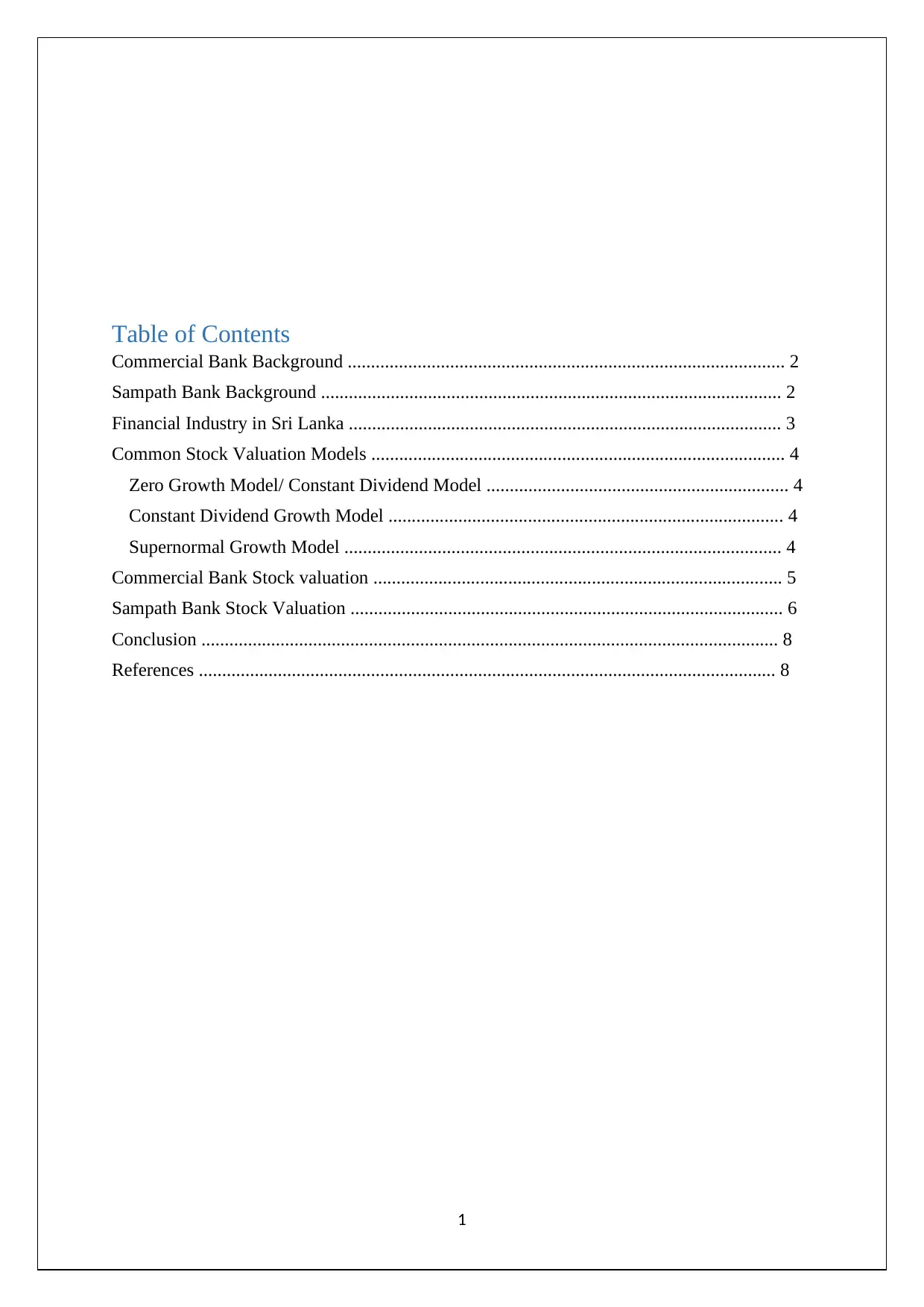
1
Table of Contents
Commercial Bank Background .............................................................................................. 2
Sampath Bank Background ................................................................................................... 2
Financial Industry in Sri Lanka ............................................................................................. 3
Common Stock Valuation Models ......................................................................................... 4
Zero Growth Model/ Constant Dividend Model ................................................................. 4
Constant Dividend Growth Model ..................................................................................... 4
Supernormal Growth Model .............................................................................................. 4
Commercial Bank Stock valuation ........................................................................................ 5
Sampath Bank Stock Valuation ............................................................................................. 6
Conclusion ............................................................................................................................ 8
References ............................................................................................................................ 8
Table of Contents
Commercial Bank Background .............................................................................................. 2
Sampath Bank Background ................................................................................................... 2
Financial Industry in Sri Lanka ............................................................................................. 3
Common Stock Valuation Models ......................................................................................... 4
Zero Growth Model/ Constant Dividend Model ................................................................. 4
Constant Dividend Growth Model ..................................................................................... 4
Supernormal Growth Model .............................................................................................. 4
Commercial Bank Stock valuation ........................................................................................ 5
Sampath Bank Stock Valuation ............................................................................................. 6
Conclusion ............................................................................................................................ 8
References ............................................................................................................................ 8
Paraphrase This Document
Need a fresh take? Get an instant paraphrase of this document with our AI Paraphraser
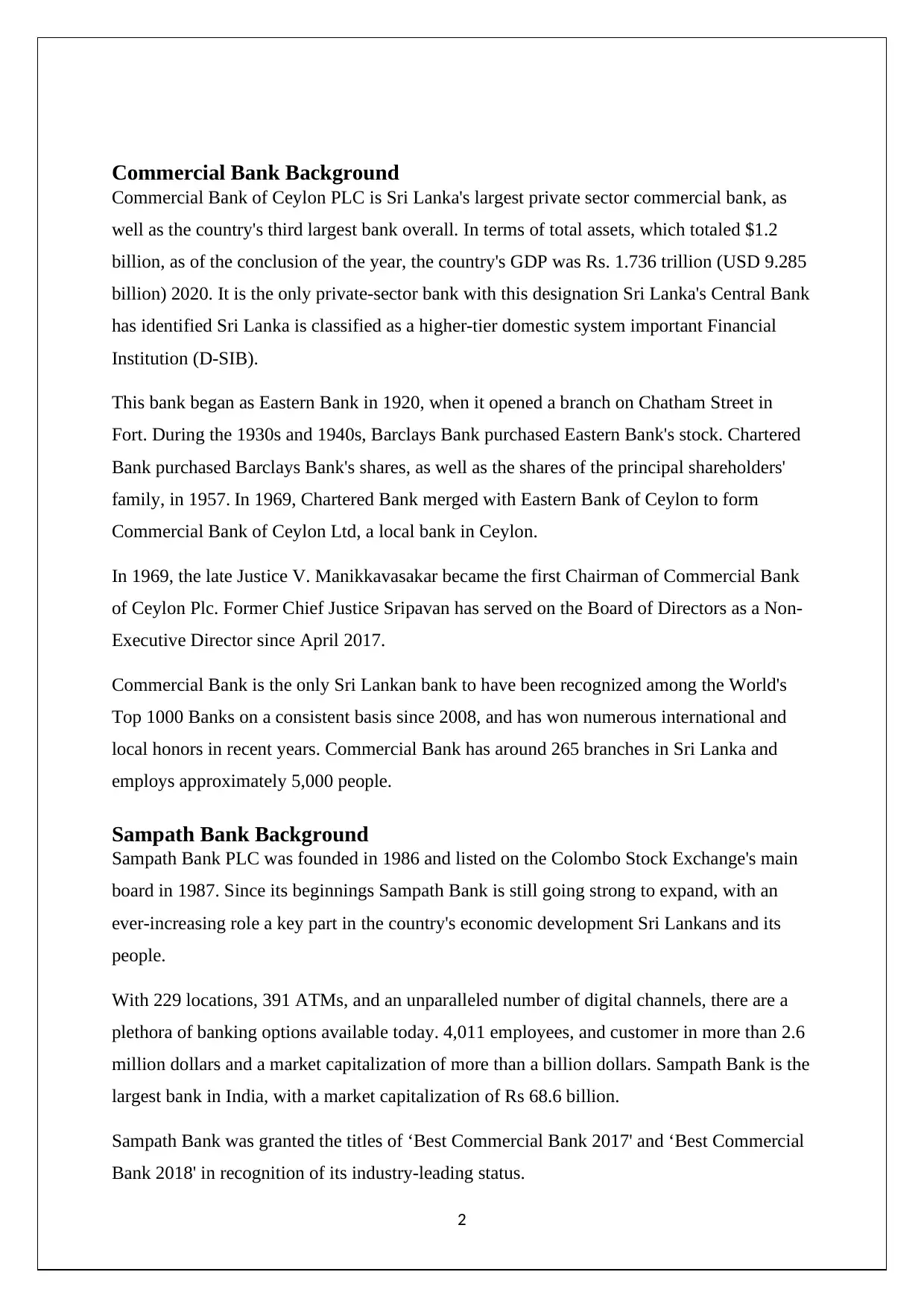
2
Commercial Bank Background
Commercial Bank of Ceylon PLC is Sri Lanka's largest private sector commercial bank, as
well as the country's third largest bank overall. In terms of total assets, which totaled $1.2
billion, as of the conclusion of the year, the country's GDP was Rs. 1.736 trillion (USD 9.285
billion) 2020. It is the only private-sector bank with this designation Sri Lanka's Central Bank
has identified Sri Lanka is classified as a higher-tier domestic system important Financial
Institution (D-SIB).
This bank began as Eastern Bank in 1920, when it opened a branch on Chatham Street in
Fort. During the 1930s and 1940s, Barclays Bank purchased Eastern Bank's stock. Chartered
Bank purchased Barclays Bank's shares, as well as the shares of the principal shareholders'
family, in 1957. In 1969, Chartered Bank merged with Eastern Bank of Ceylon to form
Commercial Bank of Ceylon Ltd, a local bank in Ceylon.
In 1969, the late Justice V. Manikkavasakar became the first Chairman of Commercial Bank
of Ceylon Plc. Former Chief Justice Sripavan has served on the Board of Directors as a Non-
Executive Director since April 2017.
Commercial Bank is the only Sri Lankan bank to have been recognized among the World's
Top 1000 Banks on a consistent basis since 2008, and has won numerous international and
local honors in recent years. Commercial Bank has around 265 branches in Sri Lanka and
employs approximately 5,000 people.
Sampath Bank Background
Sampath Bank PLC was founded in 1986 and listed on the Colombo Stock Exchange's main
board in 1987. Since its beginnings Sampath Bank is still going strong to expand, with an
ever-increasing role a key part in the country's economic development Sri Lankans and its
people.
With 229 locations, 391 ATMs, and an unparalleled number of digital channels, there are a
plethora of banking options available today. 4,011 employees, and customer in more than 2.6
million dollars and a market capitalization of more than a billion dollars. Sampath Bank is the
largest bank in India, with a market capitalization of Rs 68.6 billion.
Sampath Bank was granted the titles of ‘Best Commercial Bank 2017' and ‘Best Commercial
Bank 2018' in recognition of its industry-leading status.
Commercial Bank Background
Commercial Bank of Ceylon PLC is Sri Lanka's largest private sector commercial bank, as
well as the country's third largest bank overall. In terms of total assets, which totaled $1.2
billion, as of the conclusion of the year, the country's GDP was Rs. 1.736 trillion (USD 9.285
billion) 2020. It is the only private-sector bank with this designation Sri Lanka's Central Bank
has identified Sri Lanka is classified as a higher-tier domestic system important Financial
Institution (D-SIB).
This bank began as Eastern Bank in 1920, when it opened a branch on Chatham Street in
Fort. During the 1930s and 1940s, Barclays Bank purchased Eastern Bank's stock. Chartered
Bank purchased Barclays Bank's shares, as well as the shares of the principal shareholders'
family, in 1957. In 1969, Chartered Bank merged with Eastern Bank of Ceylon to form
Commercial Bank of Ceylon Ltd, a local bank in Ceylon.
In 1969, the late Justice V. Manikkavasakar became the first Chairman of Commercial Bank
of Ceylon Plc. Former Chief Justice Sripavan has served on the Board of Directors as a Non-
Executive Director since April 2017.
Commercial Bank is the only Sri Lankan bank to have been recognized among the World's
Top 1000 Banks on a consistent basis since 2008, and has won numerous international and
local honors in recent years. Commercial Bank has around 265 branches in Sri Lanka and
employs approximately 5,000 people.
Sampath Bank Background
Sampath Bank PLC was founded in 1986 and listed on the Colombo Stock Exchange's main
board in 1987. Since its beginnings Sampath Bank is still going strong to expand, with an
ever-increasing role a key part in the country's economic development Sri Lankans and its
people.
With 229 locations, 391 ATMs, and an unparalleled number of digital channels, there are a
plethora of banking options available today. 4,011 employees, and customer in more than 2.6
million dollars and a market capitalization of more than a billion dollars. Sampath Bank is the
largest bank in India, with a market capitalization of Rs 68.6 billion.
Sampath Bank was granted the titles of ‘Best Commercial Bank 2017' and ‘Best Commercial
Bank 2018' in recognition of its industry-leading status.
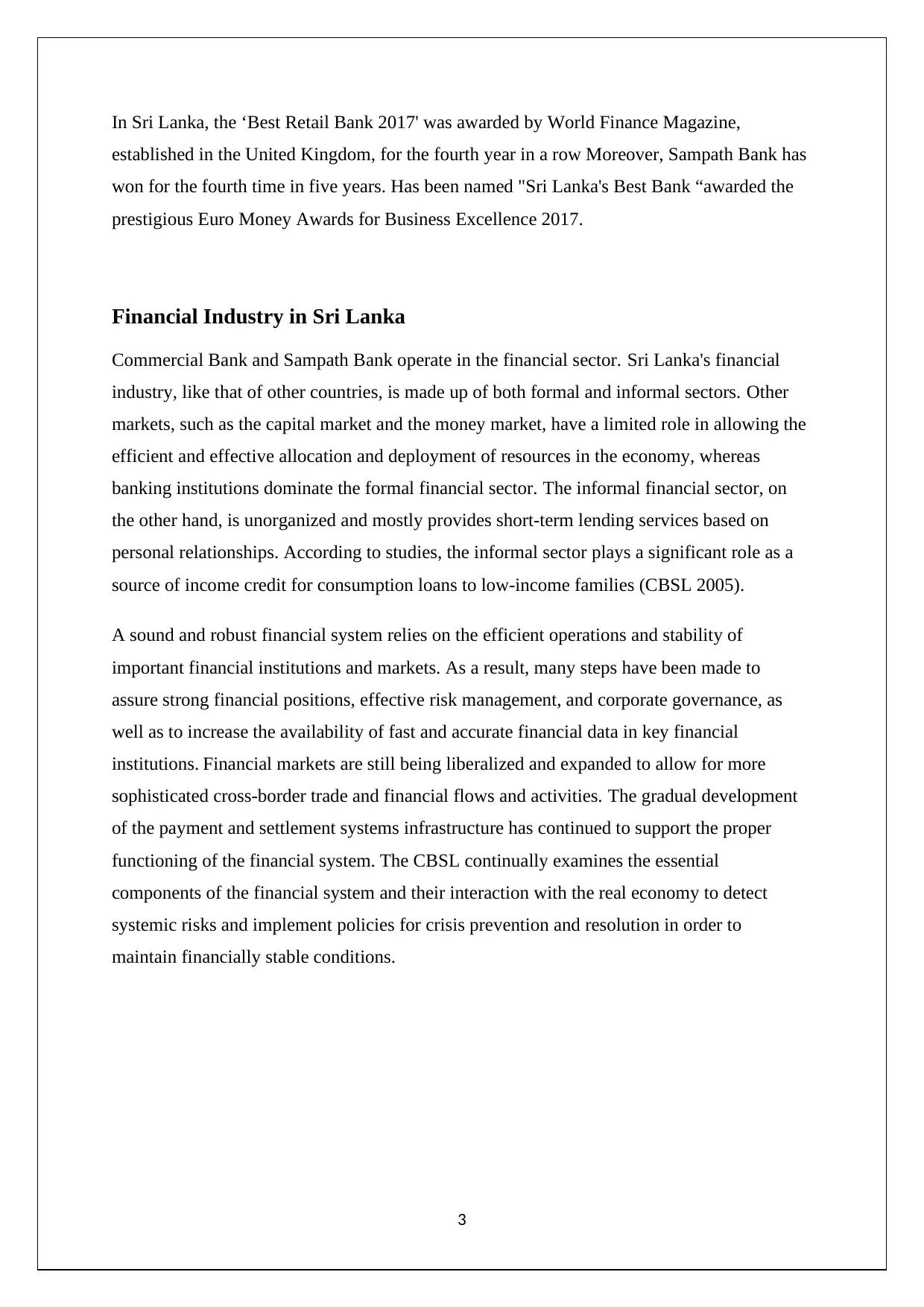
3
In Sri Lanka, the ‘Best Retail Bank 2017' was awarded by World Finance Magazine,
established in the United Kingdom, for the fourth year in a row Moreover, Sampath Bank has
won for the fourth time in five years. Has been named "Sri Lanka's Best Bank “awarded the
prestigious Euro Money Awards for Business Excellence 2017.
Financial Industry in Sri Lanka
Commercial Bank and Sampath Bank operate in the financial sector. Sri Lanka's financial
industry, like that of other countries, is made up of both formal and informal sectors. Other
markets, such as the capital market and the money market, have a limited role in allowing the
efficient and effective allocation and deployment of resources in the economy, whereas
banking institutions dominate the formal financial sector. The informal financial sector, on
the other hand, is unorganized and mostly provides short-term lending services based on
personal relationships. According to studies, the informal sector plays a significant role as a
source of income credit for consumption loans to low-income families (CBSL 2005).
A sound and robust financial system relies on the efficient operations and stability of
important financial institutions and markets. As a result, many steps have been made to
assure strong financial positions, effective risk management, and corporate governance, as
well as to increase the availability of fast and accurate financial data in key financial
institutions. Financial markets are still being liberalized and expanded to allow for more
sophisticated cross-border trade and financial flows and activities. The gradual development
of the payment and settlement systems infrastructure has continued to support the proper
functioning of the financial system. The CBSL continually examines the essential
components of the financial system and their interaction with the real economy to detect
systemic risks and implement policies for crisis prevention and resolution in order to
maintain financially stable conditions.
In Sri Lanka, the ‘Best Retail Bank 2017' was awarded by World Finance Magazine,
established in the United Kingdom, for the fourth year in a row Moreover, Sampath Bank has
won for the fourth time in five years. Has been named "Sri Lanka's Best Bank “awarded the
prestigious Euro Money Awards for Business Excellence 2017.
Financial Industry in Sri Lanka
Commercial Bank and Sampath Bank operate in the financial sector. Sri Lanka's financial
industry, like that of other countries, is made up of both formal and informal sectors. Other
markets, such as the capital market and the money market, have a limited role in allowing the
efficient and effective allocation and deployment of resources in the economy, whereas
banking institutions dominate the formal financial sector. The informal financial sector, on
the other hand, is unorganized and mostly provides short-term lending services based on
personal relationships. According to studies, the informal sector plays a significant role as a
source of income credit for consumption loans to low-income families (CBSL 2005).
A sound and robust financial system relies on the efficient operations and stability of
important financial institutions and markets. As a result, many steps have been made to
assure strong financial positions, effective risk management, and corporate governance, as
well as to increase the availability of fast and accurate financial data in key financial
institutions. Financial markets are still being liberalized and expanded to allow for more
sophisticated cross-border trade and financial flows and activities. The gradual development
of the payment and settlement systems infrastructure has continued to support the proper
functioning of the financial system. The CBSL continually examines the essential
components of the financial system and their interaction with the real economy to detect
systemic risks and implement policies for crisis prevention and resolution in order to
maintain financially stable conditions.
⊘ This is a preview!⊘
Do you want full access?
Subscribe today to unlock all pages.

Trusted by 1+ million students worldwide
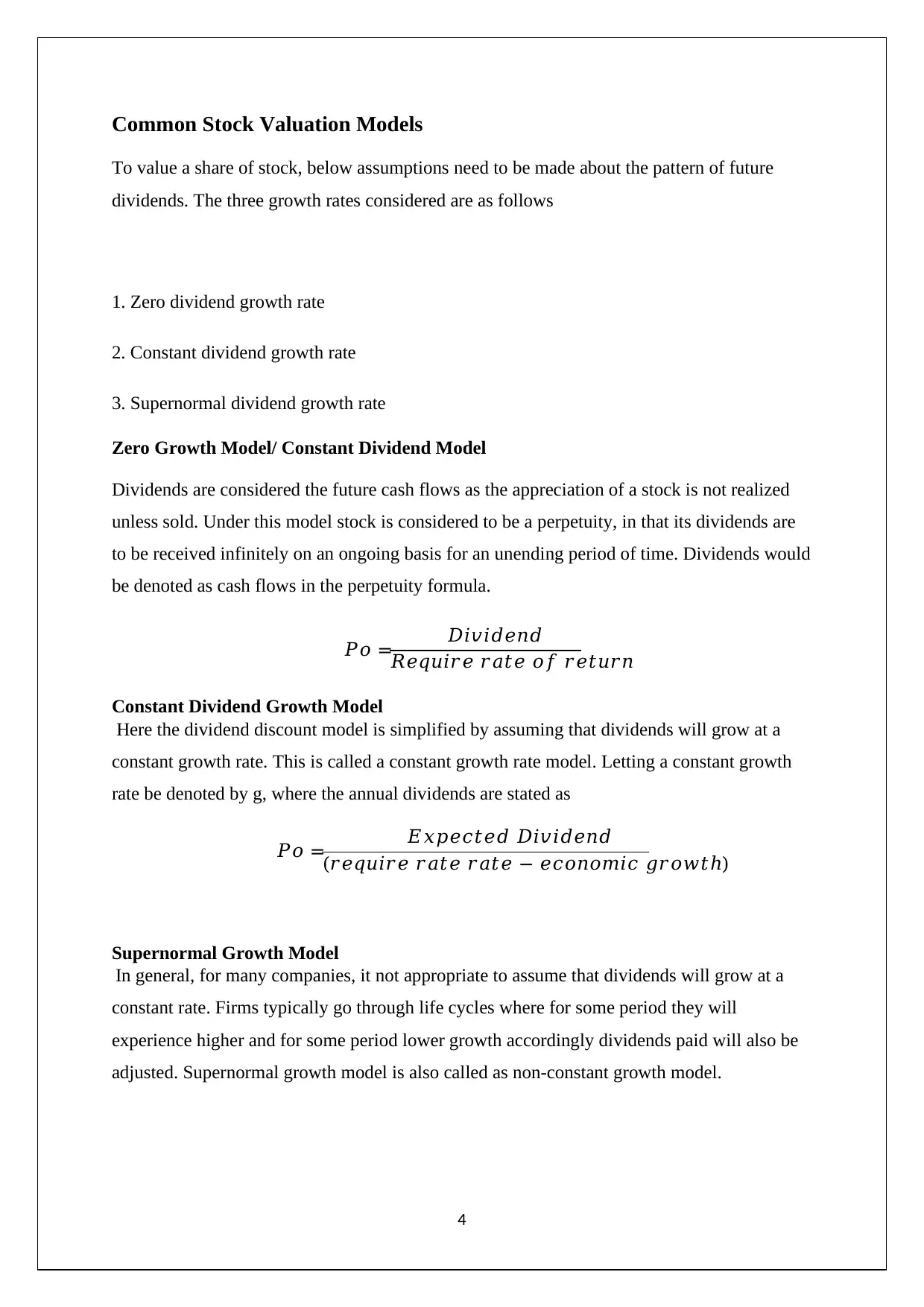
4
Common Stock Valuation Models
To value a share of stock, below assumptions need to be made about the pattern of future
dividends. The three growth rates considered are as follows
1. Zero dividend growth rate
2. Constant dividend growth rate
3. Supernormal dividend growth rate
Zero Growth Model/ Constant Dividend Model
Dividends are considered the future cash flows as the appreciation of a stock is not realized
unless sold. Under this model stock is considered to be a perpetuity, in that its dividends are
to be received infinitely on an ongoing basis for an unending period of time. Dividends would
be denoted as cash flows in the perpetuity formula.
𝑃𝑜 = 𝐷𝑖𝑣𝑖𝑑𝑒𝑛𝑑
𝑅𝑒𝑞𝑢𝑖𝑟𝑒 𝑟𝑎𝑡𝑒 𝑜𝑓 𝑟𝑒𝑡𝑢𝑟𝑛
Constant Dividend Growth Model
Here the dividend discount model is simplified by assuming that dividends will grow at a
constant growth rate. This is called a constant growth rate model. Letting a constant growth
rate be denoted by g, where the annual dividends are stated as
𝑃𝑜 = 𝐸𝑥𝑝𝑒𝑐𝑡𝑒𝑑 𝐷𝑖𝑣𝑖𝑑𝑒𝑛𝑑
(𝑟𝑒𝑞𝑢𝑖𝑟𝑒 𝑟𝑎𝑡𝑒 𝑟𝑎𝑡𝑒 − 𝑒𝑐𝑜𝑛𝑜𝑚𝑖𝑐 𝑔𝑟𝑜𝑤𝑡ℎ)
Supernormal Growth Model
In general, for many companies, it not appropriate to assume that dividends will grow at a
constant rate. Firms typically go through life cycles where for some period they will
experience higher and for some period lower growth accordingly dividends paid will also be
adjusted. Supernormal growth model is also called as non-constant growth model.
Common Stock Valuation Models
To value a share of stock, below assumptions need to be made about the pattern of future
dividends. The three growth rates considered are as follows
1. Zero dividend growth rate
2. Constant dividend growth rate
3. Supernormal dividend growth rate
Zero Growth Model/ Constant Dividend Model
Dividends are considered the future cash flows as the appreciation of a stock is not realized
unless sold. Under this model stock is considered to be a perpetuity, in that its dividends are
to be received infinitely on an ongoing basis for an unending period of time. Dividends would
be denoted as cash flows in the perpetuity formula.
𝑃𝑜 = 𝐷𝑖𝑣𝑖𝑑𝑒𝑛𝑑
𝑅𝑒𝑞𝑢𝑖𝑟𝑒 𝑟𝑎𝑡𝑒 𝑜𝑓 𝑟𝑒𝑡𝑢𝑟𝑛
Constant Dividend Growth Model
Here the dividend discount model is simplified by assuming that dividends will grow at a
constant growth rate. This is called a constant growth rate model. Letting a constant growth
rate be denoted by g, where the annual dividends are stated as
𝑃𝑜 = 𝐸𝑥𝑝𝑒𝑐𝑡𝑒𝑑 𝐷𝑖𝑣𝑖𝑑𝑒𝑛𝑑
(𝑟𝑒𝑞𝑢𝑖𝑟𝑒 𝑟𝑎𝑡𝑒 𝑟𝑎𝑡𝑒 − 𝑒𝑐𝑜𝑛𝑜𝑚𝑖𝑐 𝑔𝑟𝑜𝑤𝑡ℎ)
Supernormal Growth Model
In general, for many companies, it not appropriate to assume that dividends will grow at a
constant rate. Firms typically go through life cycles where for some period they will
experience higher and for some period lower growth accordingly dividends paid will also be
adjusted. Supernormal growth model is also called as non-constant growth model.
Paraphrase This Document
Need a fresh take? Get an instant paraphrase of this document with our AI Paraphraser
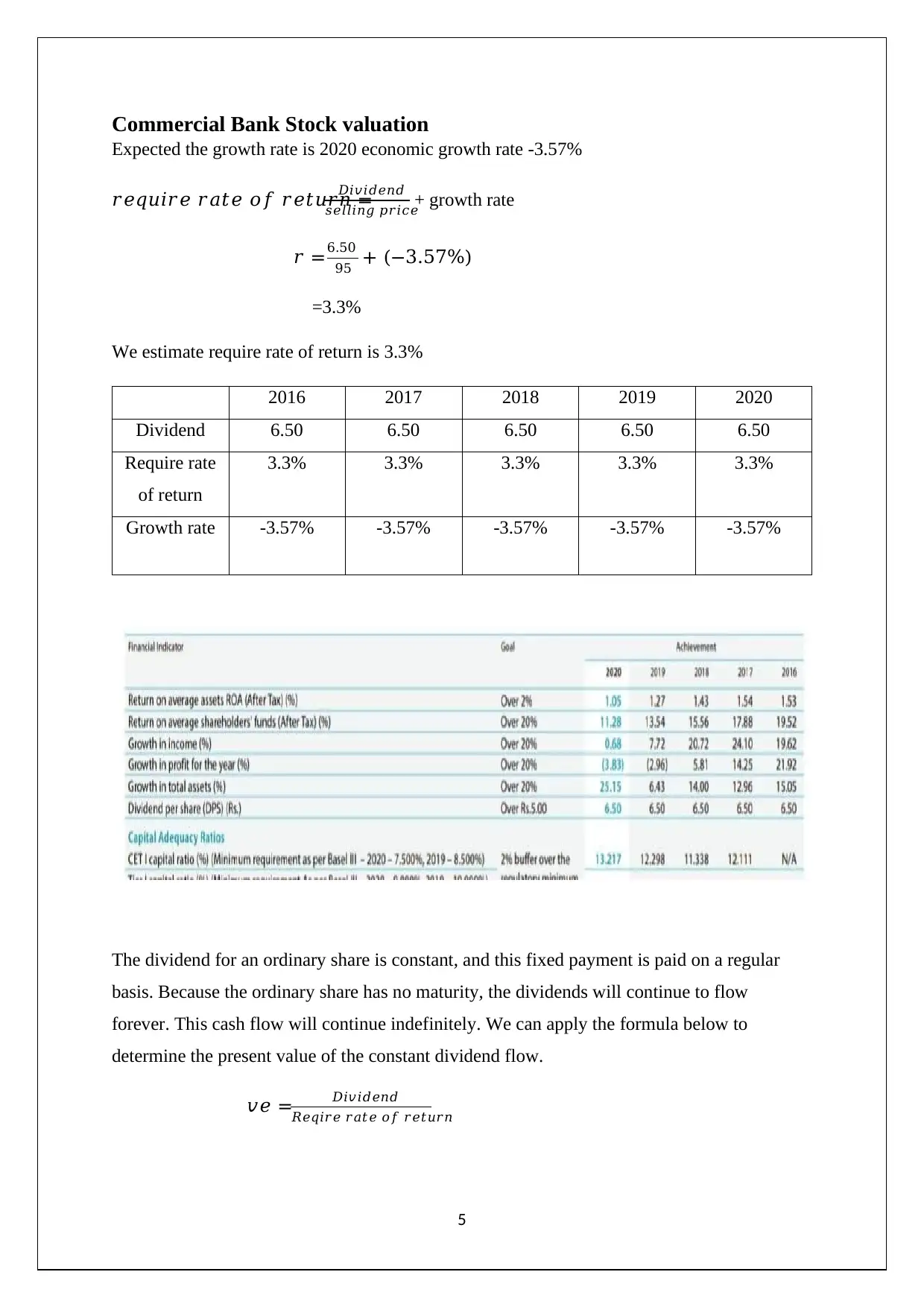
5
Commercial Bank Stock valuation
Expected the growth rate is 2020 economic growth rate -3.57%
𝑟𝑒𝑞𝑢𝑖𝑟𝑒 𝑟𝑎𝑡𝑒 𝑜𝑓 𝑟𝑒𝑡𝑢𝑟𝑛 =
𝐷𝑖𝑣𝑖𝑑𝑒𝑛𝑑
𝑠𝑒𝑙𝑙𝑖𝑛𝑔 𝑝𝑟𝑖𝑐𝑒
+ growth rate
𝑟 =6.50
95 + (−3.57%)
=3.3%
We estimate require rate of return is 3.3%
2016 2017 2018 2019 2020
Dividend 6.50 6.50 6.50 6.50 6.50
Require rate
of return
3.3% 3.3% 3.3% 3.3% 3.3%
Growth rate -3.57% -3.57% -3.57% -3.57% -3.57%
The dividend for an ordinary share is constant, and this fixed payment is paid on a regular
basis. Because the ordinary share has no maturity, the dividends will continue to flow
forever. This cash flow will continue indefinitely. We can apply the formula below to
determine the present value of the constant dividend flow.
𝑣𝑒 = 𝐷𝑖𝑣𝑖𝑑𝑒𝑛𝑑
𝑅𝑒𝑞𝑖𝑟𝑒 𝑟𝑎𝑡𝑒 𝑜𝑓 𝑟𝑒𝑡𝑢𝑟𝑛
Commercial Bank Stock valuation
Expected the growth rate is 2020 economic growth rate -3.57%
𝑟𝑒𝑞𝑢𝑖𝑟𝑒 𝑟𝑎𝑡𝑒 𝑜𝑓 𝑟𝑒𝑡𝑢𝑟𝑛 =
𝐷𝑖𝑣𝑖𝑑𝑒𝑛𝑑
𝑠𝑒𝑙𝑙𝑖𝑛𝑔 𝑝𝑟𝑖𝑐𝑒
+ growth rate
𝑟 =6.50
95 + (−3.57%)
=3.3%
We estimate require rate of return is 3.3%
2016 2017 2018 2019 2020
Dividend 6.50 6.50 6.50 6.50 6.50
Require rate
of return
3.3% 3.3% 3.3% 3.3% 3.3%
Growth rate -3.57% -3.57% -3.57% -3.57% -3.57%
The dividend for an ordinary share is constant, and this fixed payment is paid on a regular
basis. Because the ordinary share has no maturity, the dividends will continue to flow
forever. This cash flow will continue indefinitely. We can apply the formula below to
determine the present value of the constant dividend flow.
𝑣𝑒 = 𝐷𝑖𝑣𝑖𝑑𝑒𝑛𝑑
𝑅𝑒𝑞𝑖𝑟𝑒 𝑟𝑎𝑡𝑒 𝑜𝑓 𝑟𝑒𝑡𝑢𝑟𝑛
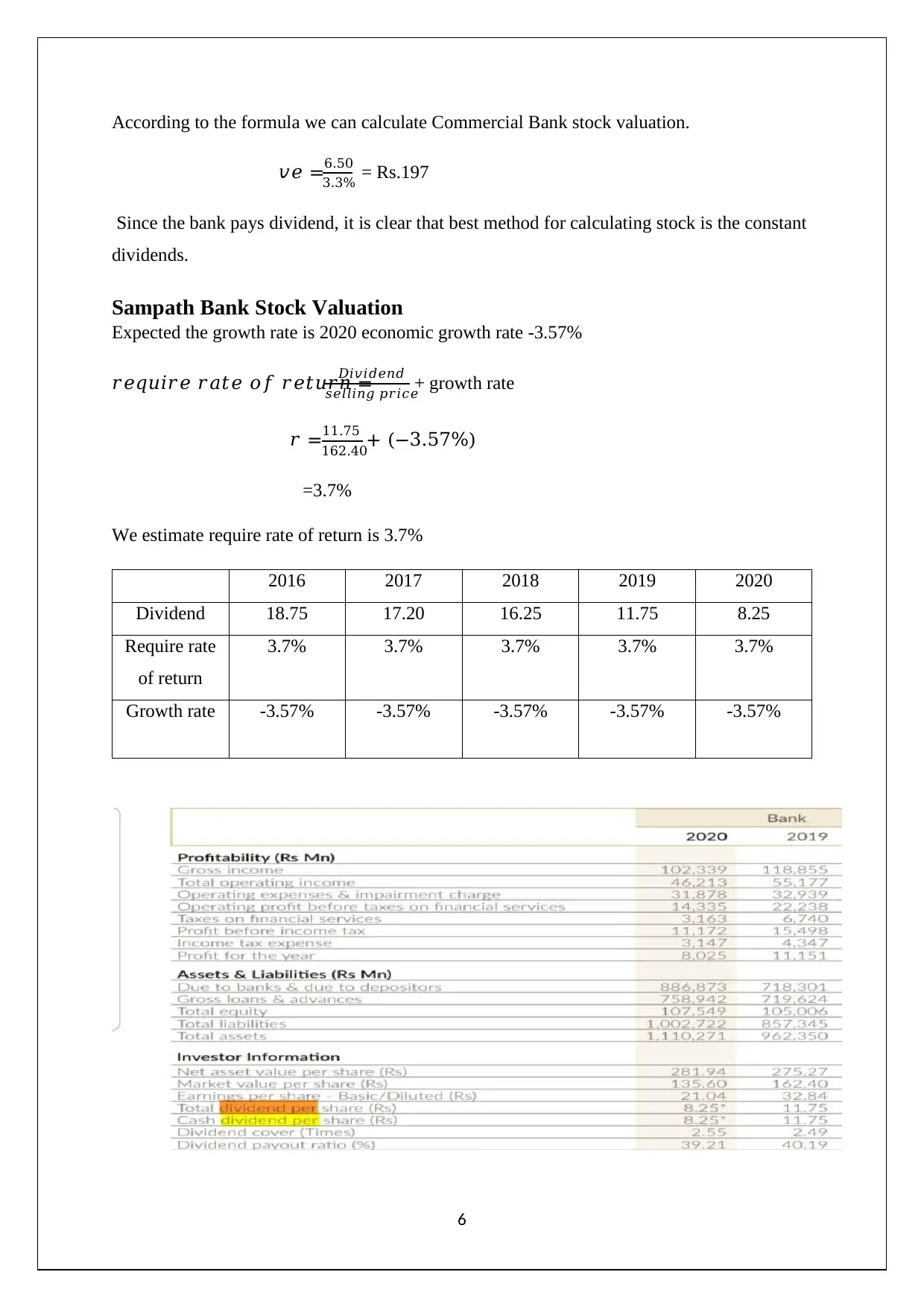
6
According to the formula we can calculate Commercial Bank stock valuation.
𝑣𝑒 =6.50
3.3% = Rs.197
Since the bank pays dividend, it is clear that best method for calculating stock is the constant
dividends.
Sampath Bank Stock Valuation
Expected the growth rate is 2020 economic growth rate -3.57%
𝑟𝑒𝑞𝑢𝑖𝑟𝑒 𝑟𝑎𝑡𝑒 𝑜𝑓 𝑟𝑒𝑡𝑢𝑟𝑛 =
𝐷𝑖𝑣𝑖𝑑𝑒𝑛𝑑
𝑠𝑒𝑙𝑙𝑖𝑛𝑔 𝑝𝑟𝑖𝑐𝑒
+ growth rate
𝑟 =11.75
162.40+ (−3.57%)
=3.7%
We estimate require rate of return is 3.7%
2016 2017 2018 2019 2020
Dividend 18.75 17.20 16.25 11.75 8.25
Require rate
of return
3.7% 3.7% 3.7% 3.7% 3.7%
Growth rate -3.57% -3.57% -3.57% -3.57% -3.57%
According to the formula we can calculate Commercial Bank stock valuation.
𝑣𝑒 =6.50
3.3% = Rs.197
Since the bank pays dividend, it is clear that best method for calculating stock is the constant
dividends.
Sampath Bank Stock Valuation
Expected the growth rate is 2020 economic growth rate -3.57%
𝑟𝑒𝑞𝑢𝑖𝑟𝑒 𝑟𝑎𝑡𝑒 𝑜𝑓 𝑟𝑒𝑡𝑢𝑟𝑛 =
𝐷𝑖𝑣𝑖𝑑𝑒𝑛𝑑
𝑠𝑒𝑙𝑙𝑖𝑛𝑔 𝑝𝑟𝑖𝑐𝑒
+ growth rate
𝑟 =11.75
162.40+ (−3.57%)
=3.7%
We estimate require rate of return is 3.7%
2016 2017 2018 2019 2020
Dividend 18.75 17.20 16.25 11.75 8.25
Require rate
of return
3.7% 3.7% 3.7% 3.7% 3.7%
Growth rate -3.57% -3.57% -3.57% -3.57% -3.57%
⊘ This is a preview!⊘
Do you want full access?
Subscribe today to unlock all pages.

Trusted by 1+ million students worldwide
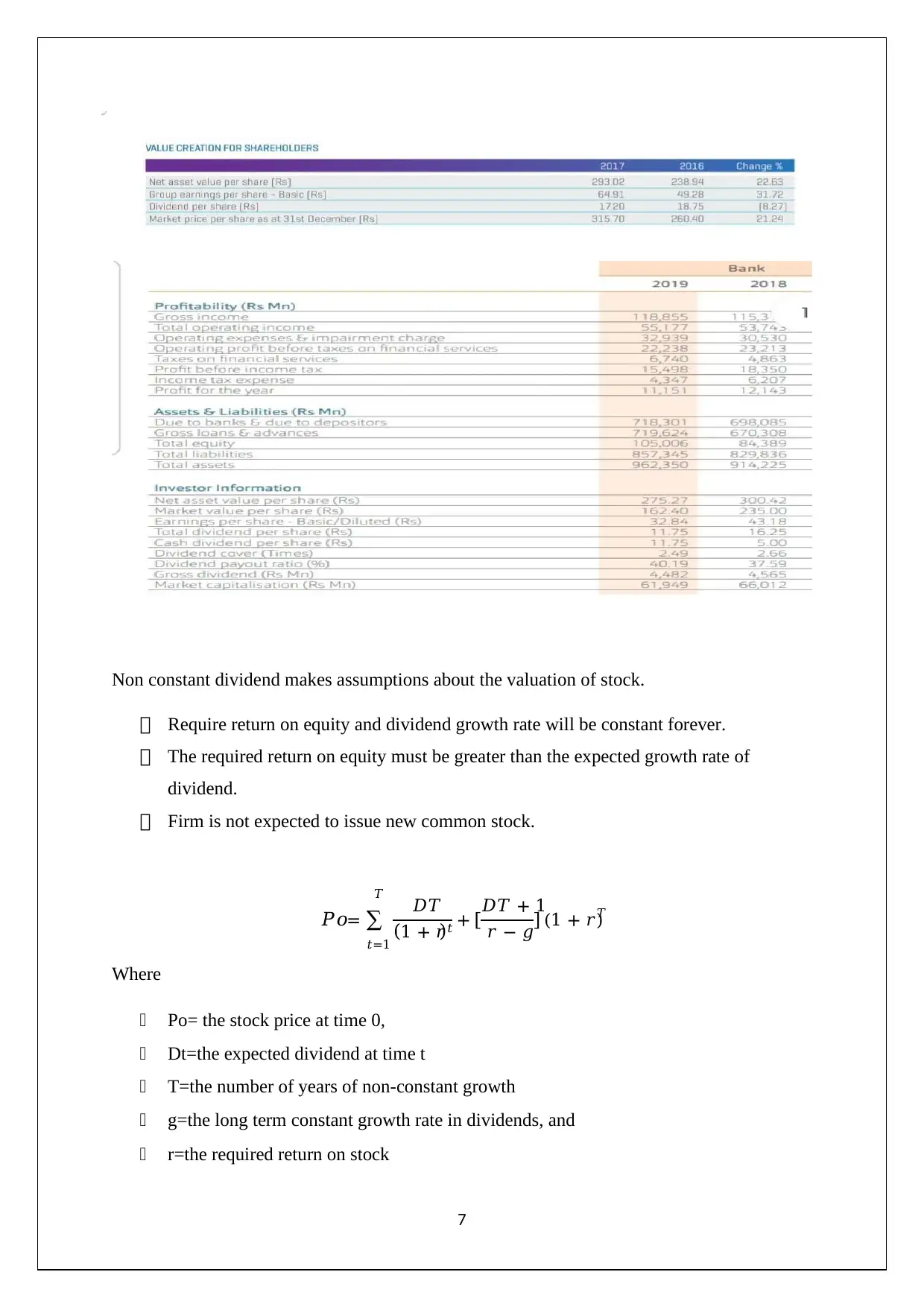
7
Non constant dividend makes assumptions about the valuation of stock.
Require return on equity and dividend growth rate will be constant forever.
The required return on equity must be greater than the expected growth rate of
dividend.
Firm is not expected to issue new common stock.
𝑃𝑜= ∑ 𝐷𝑇
(1 + 𝑟)𝑡 + [𝐷𝑇 + 1
𝑟 − 𝑔]
𝑇
𝑡=1
(1 + 𝑟)𝑇
Where
Po= the stock price at time 0,
Dt=the expected dividend at time t
T=the number of years of non-constant growth
g=the long term constant growth rate in dividends, and
r=the required return on stock
Non constant dividend makes assumptions about the valuation of stock.
Require return on equity and dividend growth rate will be constant forever.
The required return on equity must be greater than the expected growth rate of
dividend.
Firm is not expected to issue new common stock.
𝑃𝑜= ∑ 𝐷𝑇
(1 + 𝑟)𝑡 + [𝐷𝑇 + 1
𝑟 − 𝑔]
𝑇
𝑡=1
(1 + 𝑟)𝑇
Where
Po= the stock price at time 0,
Dt=the expected dividend at time t
T=the number of years of non-constant growth
g=the long term constant growth rate in dividends, and
r=the required return on stock
Paraphrase This Document
Need a fresh take? Get an instant paraphrase of this document with our AI Paraphraser
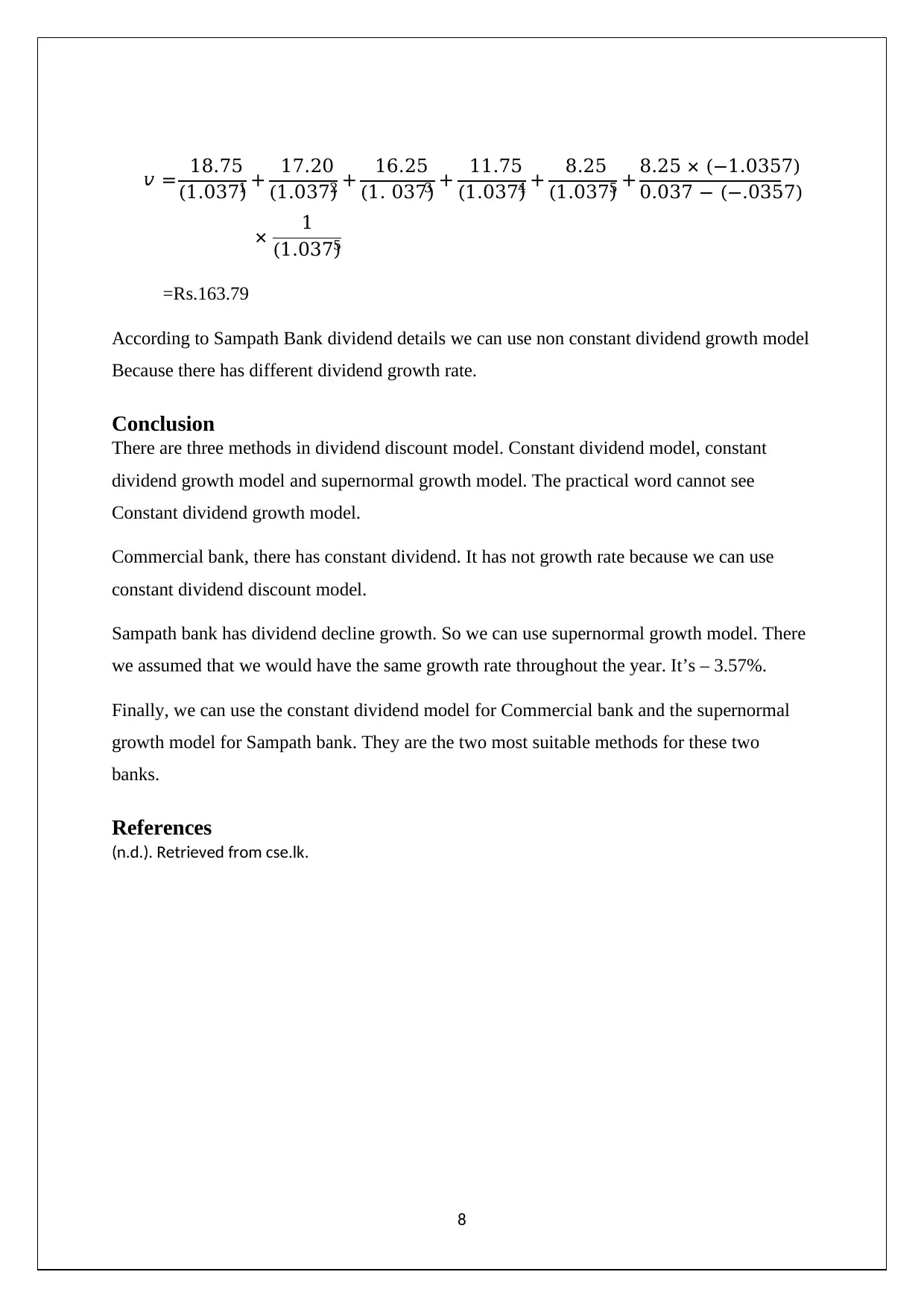
8
𝑣 = 18.75
(1.037)1 + 17.20
(1.037)2 + 16.25
(1. 037)3 + 11.75
(1.037)4 + 8.25
(1.037)5 + 8.25 × (−1.0357)
0.037 − (−.0357)
× 1
(1.037)5
=Rs.163.79
According to Sampath Bank dividend details we can use non constant dividend growth model
Because there has different dividend growth rate.
Conclusion
There are three methods in dividend discount model. Constant dividend model, constant
dividend growth model and supernormal growth model. The practical word cannot see
Constant dividend growth model.
Commercial bank, there has constant dividend. It has not growth rate because we can use
constant dividend discount model.
Sampath bank has dividend decline growth. So we can use supernormal growth model. There
we assumed that we would have the same growth rate throughout the year. It’s – 3.57%.
Finally, we can use the constant dividend model for Commercial bank and the supernormal
growth model for Sampath bank. They are the two most suitable methods for these two
banks.
References
(n.d.). Retrieved from cse.lk.
𝑣 = 18.75
(1.037)1 + 17.20
(1.037)2 + 16.25
(1. 037)3 + 11.75
(1.037)4 + 8.25
(1.037)5 + 8.25 × (−1.0357)
0.037 − (−.0357)
× 1
(1.037)5
=Rs.163.79
According to Sampath Bank dividend details we can use non constant dividend growth model
Because there has different dividend growth rate.
Conclusion
There are three methods in dividend discount model. Constant dividend model, constant
dividend growth model and supernormal growth model. The practical word cannot see
Constant dividend growth model.
Commercial bank, there has constant dividend. It has not growth rate because we can use
constant dividend discount model.
Sampath bank has dividend decline growth. So we can use supernormal growth model. There
we assumed that we would have the same growth rate throughout the year. It’s – 3.57%.
Finally, we can use the constant dividend model for Commercial bank and the supernormal
growth model for Sampath bank. They are the two most suitable methods for these two
banks.
References
(n.d.). Retrieved from cse.lk.
1 out of 8
Your All-in-One AI-Powered Toolkit for Academic Success.
+13062052269
info@desklib.com
Available 24*7 on WhatsApp / Email
![[object Object]](/_next/static/media/star-bottom.7253800d.svg)
Unlock your academic potential
Copyright © 2020–2025 A2Z Services. All Rights Reserved. Developed and managed by ZUCOL.